2020 Annual Report for: Noctuidae / Plusiinae
For species seen in 2020 that had less than or equal to 100 records, full details are included; for more common species, the earliest, latest and highest count by vice-county are shown. The narrative for each species is taken from the main Hantsmoths website, and it is possible that some information on abundance and occurrence can get out of date, as it is impossible to keep up with all changes; however it should give a good introduction to each species. The tables in each species account summarise the previous status, and that for the current year.
For the maps, all records prior to 2020 are shown by a blue dot (the larger the dot, the more recent), with the current year's records shown in red. As previous records are superimposed on any report for 2020, new sites have greater emphasis (i.e. will show as 'more red').
In the species accounts, an asterisk next to a location indicates a new 10km square record; earliest ever dates are highlighted in orange, and latest ever in red. Initials in the species accounts refer to the recorders listed here. Please get in touch if you identify any omissions or errors, in particular if you have records that have yet to be submitted. Details of how to submit records can be found here.
73.001 [B&F: 2450] Spectacle Abrostola tripartita (Hufnagel, 1766) - Common
Common in gardens, heathland, rough grassland, fens, woodland edges and waste ground throughout the British Isles. Widespread and common in Hampshire and on the Isle of Wight. Wingspan 34-38 mm. The main confusion species is Dark Spectacle A. triplasia, which see. Larva feeds on Stinging Nettle, over-wintering as a pupa.
Records prior to 2020
| Vice County | #Records | #Individuals | First Record | Last Record |
|---|---|---|---|---|
| 10 | 876 | 1403 | 1951 | 2019 |
| 11 | 8591 | 11328 | 1951 | 2019 |
| 12 | 2948 | 4598 | 1949 | 2019 |
2020 records
| Vice County | #Records | #Individuals | Max Quantity |
|---|---|---|---|
| 10 | 63 | 103 | 9 |
| 11 | 222 | 253 | 5 |
| 12 | 102 | 134 | 5 |
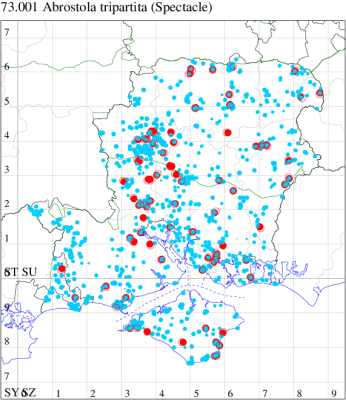
Records by year
Records by week (adult)
Records by week (larval)
Record Summary
VC10: Earliest: West High Down Quarry, 07 Aug, 3 (IOu) Latest: Sandown, 02 Aug, 1 (JMar) Max count: Haseley Manor, 11 Aug, 9 (IOu)
VC11: Earliest: Brockwood, 26 Apr, 1 (SDut) Latest: Pennington, 17 Aug, 2 (RFC) Max count: Romsey, 14 Aug, 5 (MB)
VC12: Earliest: Cholderton, 10 Jul, 1 (TJN, HE) Latest: Yateley, 08 Aug, 2 (JHH) Max count: Cholderton, 08 Aug, 5 (TJN, HE)
73.002 [B&F: 2449] Dark Spectacle Abrostola triplasia (Linnaeus, 1758) - Common
Common in a wide range of habitats, including river-banks, hedgerows and gardens throughout the British Isles, but rare in Scotland; far less numerous and less widely distributed in Hampshire and the Isle of Wight than Spectacle A. tripartita. Wingspan 34-40 mm. Similar to A. tripartita, but ground-colour is brownish black, base of forewing is dull straw or reddish brown and cross-lines are edged with reddish brown (MBGBI Vol 10). Larva feeds on Stinging Nettle and Hop, over-wintering as a pupa.
Records prior to 2020
| Vice County | #Records | #Individuals | First Record | Last Record |
|---|---|---|---|---|
| 10 | 286 | 359 | 1943 | 2019 |
| 11 | 653 | 685 | 1951 | 2019 |
| 12 | 109 | 114 | 1951 | 2019 |
2020 records
| Vice County | #Records | #Individuals | Max Quantity |
|---|---|---|---|
| 10 | 8 | 8 | 1 |
| 11 | 29 | 28 | 3 |
| 12 | 5 | 5 | 1 |
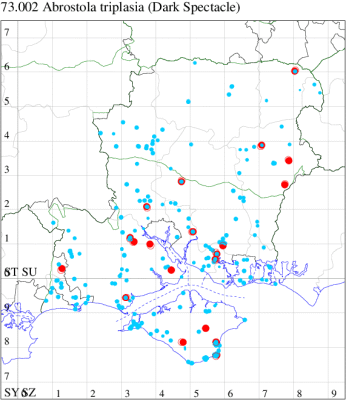
Records by year
Records by week (adult)
Records by week (larval)
Record Details
VC10: Kingston, one, 29 Jul (ENes); Bonchurch, one, 13 Jul (JHa); Haseley Manor, one, 28 May; Shanklin, one, 25 Jun; one, 09 Aug; one, 13 Aug; one, 26 Aug; one, 15 Sep (IOu);
VC11: Brockwood, one, 22 Aug (SDut); Marchwood, one, 09 Sep (CTh); Woodlands, New Forest, present, 30 May (RBW); Ashurst, NF, one, 06 Aug; three, 07 Aug; one, 10 Aug; two, 12 Aug (SAB); Romsey, one, 07 Jun; one, 16 Jul; one, 14 Aug; two, 18 Aug (MB); Blackfied, one, to lighted window, 24 May (PGS); Winchester, one, 17 Jul; one, 14 Aug (THW); Fareham, one, 24 Jun (IMcP); one, 17 Aug (KJW); Wickham, one, 07 Aug (F.M.G.); Botley, one, to actinic, 16 Jul; one, to actinic, 24 Jul (SLB); Northney, Hayling Island, present, 15 Jun; present, 19 Jun; present, 07 Jul; present, 05 Aug; present, 21 Aug (JWP); Pennington, two, 10 Aug; one, 14 Oct; one, 16 Oct (RFC);
VC12: Liss*, one, 31 Jul; one, 07 Aug (LBe); Alton, one, to actinic, 13 Aug (BCA); Whitehill, one, to actinic, 18 Jul (ASto); Yateley, one, 14 Sep (JHH)
73.004 [B&F: 2433] Slender Burnished Brass Thysanoplusia orichalcea (Fabricius, 1775) - Migrant
Rare immigrant from North Africa, appearing in southern England in small numbers. In 1969 at least ten were reported; although the records were spread over eight weeks, the concentration in mid-October appears to have been part of a very large immigration which included other scarce species. In Hampshire and on the Isle of Wight there have been about ten records to date. Wingspan 38-48 mm. The far more common Burnished Brass Diachrysia chrysitis has the thorax and abdomen stouter and forewing broader, with basal portion of the metallic patch extending from costa to dorsum; in Slender Burnished Brass most of the forewing is filled by a triangular greenish-brassy area, narrowly bordered at termen, more broadly at costa and dorsum, with pale purplish grey (MBGBI Vol 10). Larva polyphagous, no evidence of breeding in the UK.
Records prior to 2020
| Vice County | #Records | #Individuals | First Record | Last Record |
|---|---|---|---|---|
| 10 | 5 | 4 | 1961 | 2006 |
| 11 | 10 | 6 | 1951 | 2018 |
| 12 | 1 | 0 | 1981 | 1981 |
2020 records
| Vice County | #Records | #Individuals | Max Quantity |
|---|---|---|---|
| 10 | 1 | 1 | 1 |
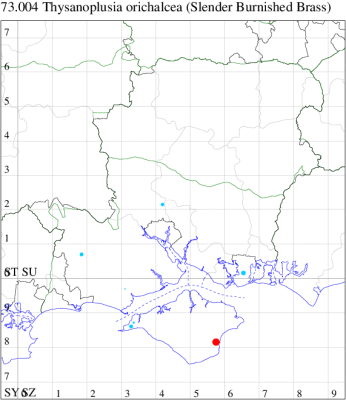
Records by year
Records by week (adult)
Records by week (larval)
Record Details
VC10: Shanklin*, one, 23 Aug (IOu)
73.010 [B&F: 2436] Dewick's Plusia Macdunnoughia confusa (Stephens, 1850) - Recent colonist
Rare immigrant from mainland Europe, appearing in south-eastern England for the first time at Bradwell-on-Sea, Essex, on 3 October 1951. From about 1920 had spread rapidly into Western Europe from the central Palaearctic, and has been seen increasingly in Britain, especially in the last ten years. In Hampshire and on the Isle of Wight recorded for the first time in August 1991, and then again in 1998, 1999 and 2001 (the first for Wight); 2003 to 2006 saw a further six, with another six in 2007, 11 in 2008 and another six in 2009. This pattern has been maintained up to the present year and increasingly extending its range into the north of the county, which may be originating from the London population spreading west. Wingspan 32-38 mm. Fairly distinctive. Larva feeds on herbaceous plants such as Stinging Nettle, Yarrow, Corn Chamomile, Stinking Chamomile and Wormwood; breeding has been confirmed in Middlesex and is probably established elsewhere.
Records prior to 2020
| Vice County | #Records | #Individuals | First Record | Last Record |
|---|---|---|---|---|
| 10 | 16 | 17 | 2001 | 2019 |
| 11 | 46 | 43 | 1991 | 2019 |
| 12 | 6 | 6 | 1998 | 2019 |
2020 records
| Vice County | #Records | #Individuals | Max Quantity |
|---|---|---|---|
| 10 | 2 | 2 | 1 |
| 11 | 8 | 7 | 1 |
| 12 | 2 | 2 | 1 |
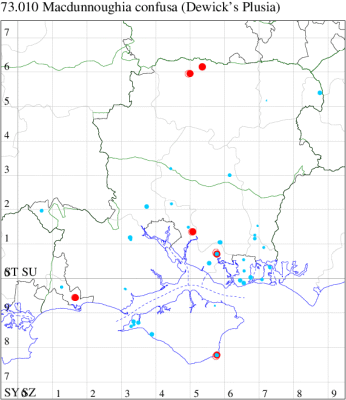
Records by year
Records by week (adult)
Records by week (larval)
Record Details
VC10: Bonchurch, one, 05 Oct; one, 22 Oct (JHa);
VC11: Southampton, one, 06 Aug (MEdg); Sholing, Southampton, one, new to garden, 15 Sep (ARC); Fareham, one, to a lighted window, 22 Sep (KJW); Botley, one, to actinic, 24 Jul (SLB); Dean, Bishop's Waltham, one, 22 May (CMor); Northney, Hayling Island, present, 26 Jun (JWP); Burton, nr Christchurch, one, 18 Sep (JSw);
VC12: Ecchinswell*, one, field observation, 29 May (MTa, CSu); Plastow Green*, one, 09 May (Unknown det. MJW)
73.012 [B&F: 2434] Burnished Brass Diachrysia chrysitis (Linnaeus, 1758) - Common
Common in a wide variety of habitats, including gardens, hedgerows, river-banks, fens, woodland edges and rough grassland throughout the British Isles. Widespread and common in Hampshire and on the Isle of Wight. Wingspan 35-43 mm. Superficially resembles the rare immigrant Slender Burnished Brass Thysanoplusia orichalcea and nationally scarce Scarce Burnished Brass Diachrysia chryson, which see for differences. Larva feeds on Stinging Nettle, White Dead-nettle, Wild Marjoram, Lesser Burdock and Spear Thistle.
Records prior to 2020
| Vice County | #Records | #Individuals | First Record | Last Record |
|---|---|---|---|---|
| 10 | 370 | 419 | 1951 | 2019 |
| 11 | 3838 | 5147 | 1943 | 2019 |
| 12 | 2560 | 4362 | 1948 | 2019 |
2020 records
| Vice County | #Records | #Individuals | Max Quantity |
|---|---|---|---|
| 10 | 48 | 80 | 10 |
| 11 | 66 | 65 | 3 |
| 12 | 102 | 136 | 5 |
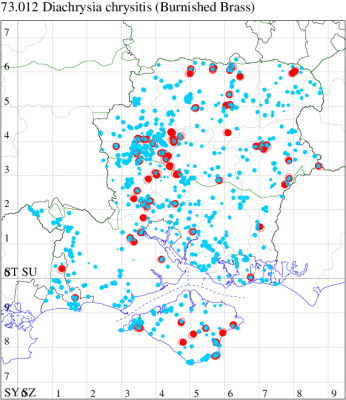
Records by year
Records by week (adult)
Records by week (larval)
Record Summary
VC10: Earliest: Freshwater Bay, 14 Sep, 2 (SDa) Latest: Bembridge Fort, 06 Aug, 1 (IOu) Max count: Haseley Manor, 09 Jun, 10 (IOu)
VC11: Earliest: Brockwood, 12 Sep, 1 (SDut) Latest: Burton, nr Christchurch, 11 Sep, 1 (JSw) Max count: Stockbridge Down NT, 19 Jun, 3 (GCE)
VC12: Earliest: Over Wallop, 21 May, 1 (CM) Latest: Yateley, 26 May, 1 (JHH) Max count: Teg Down, Winchester, 27 Aug, 5 (CKn)
73.014 [B&F: 2437] Golden Plusia Polychrysia moneta (Fabricius, 1787) - Common
Common in gardens and parks throughout much of England and Wales. In Hampshire and on the Isle of Wight first became established in the county in the late 19th Century, becoming a moderately common cottage garden species, taking advantage of cultivated species of Delphinium and Aconitum. It then decreased in numbers quite dramatically, possibly due to the increased usage of insecticides in gardens, but is still reported occasionally. Wingspan 38-44 mm. Fairly distinctive. Larva feeds on flower buds, leaves and seeds of Larkspur.
Records prior to 2020
| Vice County | #Records | #Individuals | First Record | Last Record |
|---|---|---|---|---|
| 10 | 8 | 2 | 1950 | 1997 |
| 11 | 200 | 138 | 1951 | 2015 |
| 12 | 103 | 66 | 1951 | 2018 |
2020 records
| Vice County | #Records | #Individuals | Max Quantity |
|---|---|---|---|
| 11 | 1 | 1 | 1 |
| 12 | 2 | 2 | 1 |
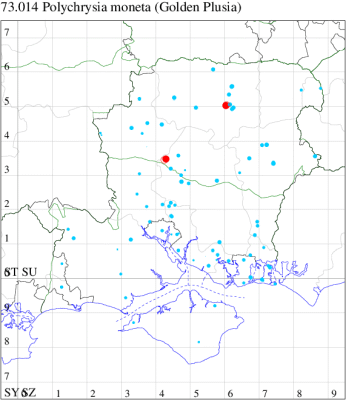
Records by year
Records by week (adult)
Records by week (larval)
Record Details
VC12: Crawley, one, 30 May (TNo); Basingstoke, one, 27 May (DLev)
73.015 [B&F: 2441] Silver Y Autographa gamma (Linnaeus, 1758) - Migrant
Common immigrant from mainland Europe, appearing throughout the British Isles, in most years arriving in sufficient numbers to breed. In Hampshire and on the Isle of Wight sometimes abundant, with numbers boosted, in good years, by the offspring of earlier migrants. Wingspan 40-48 mm. A familiar and conspicuous moth, often seen by day nectaring in a wide range of habitats, when confusion with Humming-bird Hawk-moth Macroglossum stellatarum is possible. Larva polyphagous on plants such as Stinging Nettle, Hedge Bedstraw, Clover, brassicas and legumes, causing sufficient damage to be a serious pest in some areas; unable to over-winter in significant numbers.
Records prior to 2020
| Vice County | #Records | #Individuals | First Record | Last Record |
|---|---|---|---|---|
| 10 | 2854 | 15726 | 1957 | 2019 |
| 11 | 19989 | 61873 | 1951 | 2019 |
| 12 | 5707 | 15356 | 1951 | 2019 |
2020 records
| Vice County | #Records | #Individuals | Max Quantity |
|---|---|---|---|
| 10 | 173 | 407 | 23 |
| 11 | 801 | 1233 | 20 |
| 12 | 322 | 488 | 15 |
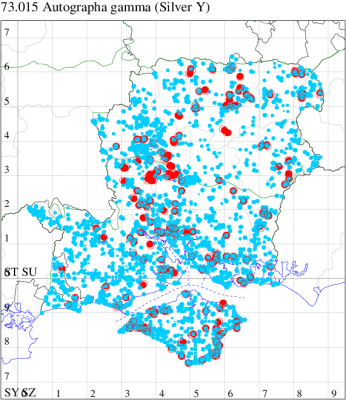
Records by year
Records by week (adult)
Records by week (larval)
Record Summary
VC10: Earliest: West High Down Quarry, 07 Aug, 3 (IOu) Latest: Bembridge Marsh, 31 May, 2 (IOu) Max count: Shanklin, 16 Aug, 23 (IOu)
VC11: Earliest: Brockwood, 30 Jul, 1 (SDut) Latest: Southsea, 17 Nov, 1 (JRL) Max count: Breamore Down, 20 Aug, 19 (MGib)
VC12: Earliest: Stoney Cross, NF, 12 Aug, 1 (MDu) Latest: Yateley, 08 Sep, 2 (JHH) Max count: Stockbridge Down, 20 Aug, 15 (ACB)
73.016 [B&F: 2442] Beautiful Golden Y Autographa pulchrina (Haworth, 1809) - Common
Common in woodland, hedgerows, gardens, scrubby grassland, moorland and heathland throughout the British Isles. In Hampshire and on the Isle of Wight fairly widespread and common. Wingspan 36-44 mm. The main confusion species is Plain Golden Y A. jota, in which reniform stigma is indistinct or absent. Larva feeds predominantly on Stinging Nettle, but also on Hedge Woundwort, Common Ragwort, Water Avens and Honeysuckle.
Records prior to 2020
| Vice County | #Records | #Individuals | First Record | Last Record |
|---|---|---|---|---|
| 10 | 87 | 79 | 1909 | 2019 |
| 11 | 687 | 715 | 1949 | 2019 |
| 12 | 536 | 591 | 1951 | 2019 |
2020 records
| Vice County | #Records | #Individuals | Max Quantity |
|---|---|---|---|
| 10 | 3 | 3 | 1 |
| 11 | 12 | 13 | 2 |
| 12 | 7 | 8 | 2 |
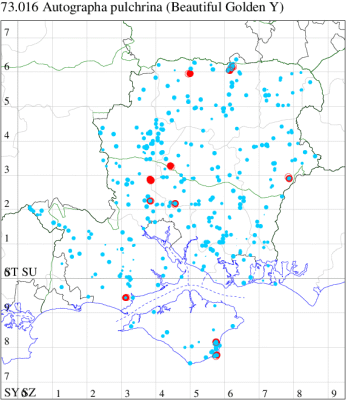
Records by year
Records by week (adult)
Records by week (larval)
Record Details
VC10: Bonchurch, one, 13 Jul (JHa); Shanklin, one, 24 Jun; one, 25 Jun (IOu);
VC11: Romsey, one, 17 Jun; one, 20 Jun (NRJ); Kings Somborne, two, to actinic, 11 Jun; one, to actinic, 11 Jun; one, to actinic, 11 Jun (GCE); Allbrook, one, 16 Jun; one, to actinic, 30 Jun (SI); Wickham, one, 21 Jun; one, 22 Jun (JRDS); Pennington, one, 22 Aug (RFC);
VC12: Crawley, two, to actinic, 09 Jun (GCE); Ecchinswell, one, to actinic, 24 Jun (MTa, CSu); Pamber Forest, one, 28 May; one, 17 Jun (GJD); Liss Forest, one, 27 Jun; one, 04 Jul (RJM)
73.017 [B&F: 2443] Plain Golden Y Autographa jota (Linnaeus, 1758) - Common
Common in a wide range of habitats, including woodland, downland, hedgerows and gardens throughout the British Isles. In Hampshire and on the Isle of Wight fairly widespread and common. Wingspan 39-45 mm. The main confusion species is Beautiful Golden Y A. pulchrina, in which reniform stigma dark purplish brown, dorsal half at least finely outlined pale golden (MBGBI Vol 10). Larva feeds on a wide variety of plants, including Stinging Nettle, White Dead-nettle, Red Dead-nettle, Hogweed and Honeysuckle.
Records prior to 2020
| Vice County | #Records | #Individuals | First Record | Last Record |
|---|---|---|---|---|
| 10 | 69 | 62 | 1856 | 2019 |
| 11 | 347 | 465 | 1951 | 2019 |
| 12 | 590 | 785 | 1949 | 2019 |
2020 records
| Vice County | #Records | #Individuals | Max Quantity |
|---|---|---|---|
| 10 | 3 | 3 | 1 |
| 11 | 4 | 4 | 1 |
| 12 | 5 | 5 | 1 |
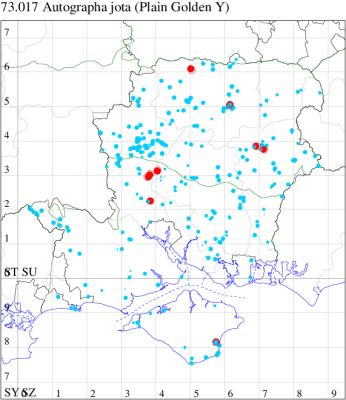
Records by year
Records by week (adult)
Records by week (larval)
Record Details
VC10: Shanklin, one, 16 Jun; one, 17 Jun; one, 06 Jul (IOu);
VC11: Kings Somborne, one, to actinic, 23 Jun (GCE); Romsey, one, 22 Jun (NRJ); Ashley, one, to actinic, 23 Jun; Kings Somborne, one, to actinic, 15 Jun (GCE);
VC12: Ecchinswell, one, 22 Jun (MJN); Beech, one, 21 Jun; one, 30 Jun (NDP); Basingstoke, one, 24 Jun (RHil); Chawton, one, 02 Jul (DAS)
73.022 [B&F: 2439] Gold Spot Plusia festucae (Linnaeus, 1758) - Common
Common in marshes, fens, woodland rides and upland grassland, and on heathland, moorland and river-banks throughout the British Isles. In Hampshire and on the Isle of Wight an uncommon resident, mainly in coastal marshes and less commonly in the river valleys, occasional wanderers may turn up elsewhere. Wingspan 35-40 mm. The main confusion species, Lempke's Gold Spot P. putnami, is rare in the south of England, and differs in having the more distal of the silver median spots smaller and more rounded, and the subapical silver streak shorter and thicker, but can often only be separated by dissection of the genitalia. Larva feeds on various sedges, including Tufted Sedge and Glaucous Sedge, and other waterside plants.
Records prior to 2020
| Vice County | #Records | #Individuals | First Record | Last Record |
|---|---|---|---|---|
| 10 | 142 | 191 | 1856 | 2019 |
| 11 | 724 | 785 | 1951 | 2019 |
| 12 | 98 | 99 | 1951 | 2019 |
2020 records
| Vice County | #Records | #Individuals | Max Quantity |
|---|---|---|---|
| 10 | 12 | 18 | 6 |
| 11 | 23 | 20 | 4 |
| 12 | 7 | 8 | 2 |
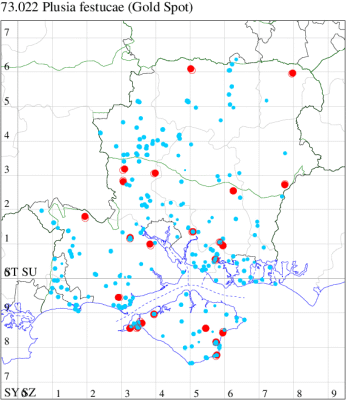
Records by year
Records by week (adult)
Records by week (larval)
Record Details
VC10: West High Down Quarry, three, 07 Aug (IOu); Freshwater Cliffs, one, 11 May; one, 03 Aug (SDa); Freshwater, one, to actinic, 20 Sep (PBa); Cranmore, present, to actinic, 04 Aug (CHic); Bonchurch, one, 25 May (JHa); Haseley Manor, one, 09 Jun; six, 11 Aug; Shanklin, one, 26 May; one, 08 Aug; one, 20 Aug (IOu); Sandown, one, to actinic, 01 Aug (JMar);
VC11: Hale Purlieu, one, to actinic, 13 Aug (MCu); Marchwood, one, 24 Apr (CTh); Woodlands, New Forest, present, 19 May (RBW); East Tytherley, one, to actinic, 10 Aug; Broughton, one, to actinic, 06 Aug; Kings Somborne, one, to actinic, 07 Aug (GCE); Fareham, one, 31 Jul (IMcP); Wickham, four, 07 Aug (F.M.G.); Botley, one, to actinic, 04 Aug; one, to actinic, 14 Aug (SLB); Wickham Common, one, 02 Aug (KC); Wickham, one, 07 Aug; one, 10 Aug; one, 16 Aug (JRDS); West Meon, one, 31 Jul (F.M.G.); Northney, Hayling Island, present, 26 May; present, 17 Jun; present, 18 Jun; present, 20 Jun; present, 25 Jun (JWP); Everton, one, 29 Jul (MMcM); Pilley Bailey, NF, one, 03 Aug (RBW, MWa);
VC12: Cholderton, one, 24 Jul; two, 08 Aug (TJN, HE); Anna Valley, Andover, one, 30 Jul (TJN); Ecchinswell*, one, 08 Aug (MJN); Liss, one, 16 May; one, 31 Jul (LBe); Castle Bottom NNR, one, to actinic, 16 Aug (JHH)

()().jpg)
